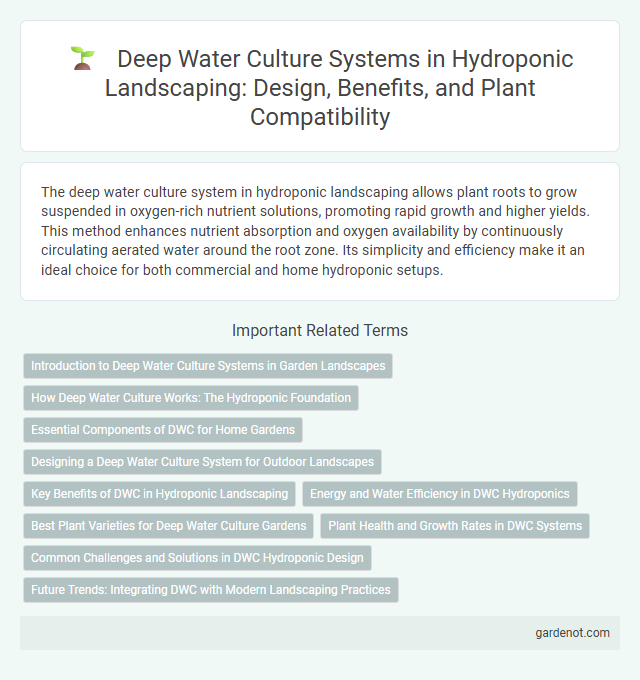The deep water culture system in hydroponic landscaping allows plant roots to grow suspended in oxygen-rich nutrient solutions, promoting rapid growth and higher yields. This method enhances nutrient absorption and oxygen availability by continuously circulating aerated water around the root zone. Its simplicity and efficiency make it an ideal choice for both commercial and home hydroponic setups.
Introduction to Deep Water Culture Systems in Garden Landscapes
Deep Water Culture (DWC) systems immerse plant roots directly in oxygen-rich nutrient solutions, promoting rapid growth in garden landscapes. This hydroponic technique enhances nutrient uptake and reduces soil-borne diseases, making it ideal for urban gardens and limited spaces. Efficient oxygen delivery and consistent nutrient circulation in DWC maximize plant health and yield in sustainable landscape designs.
How Deep Water Culture Works: The Hydroponic Foundation
Deep Water Culture (DWC) hydroponic systems work by suspending plant roots in a nutrient-rich, oxygenated water solution, allowing for continuous absorption of essential minerals. An air pump provides constant oxygen through air stones, preventing root rot and promoting vigorous growth. This method ensures rapid nutrient uptake, making DWC a highly efficient hydroponic foundation for producing healthy, fast-growing plants.
Essential Components of DWC for Home Gardens
Deep Water Culture (DWC) systems for home gardens rely on three essential components: an oxygen-rich nutrient solution, a sturdy growth container, and an air pump with air stones. The nutrient solution provides vital minerals directly to plant roots submerged in water, while the air pump ensures adequate oxygenation to prevent root rot and promote healthy growth. Using net pots with inert growing media stabilizes plants, allowing efficient nutrient uptake and maximizing yield in compact hydroponic setups.
Designing a Deep Water Culture System for Outdoor Landscapes
Designing a Deep Water Culture (DWC) system for outdoor landscapes requires selecting durable, weather-resistant materials such as UV-stabilized plastics and marine-grade metals to ensure longevity. Incorporating robust aeration systems, including high-capacity air pumps and diffuser stones, maintains optimal oxygen levels essential for healthy root development in fluctuating outdoor temperatures. Positioning the DWC system to maximize sunlight exposure while providing shade during peak heat protects plants from stress and supports vigorous growth.
Key Benefits of DWC in Hydroponic Landscaping
Deep Water Culture (DWC) systems provide rapid plant growth due to continuous oxygen supply and nutrient availability directly to the roots, enhancing overall yield in hydroponic landscaping. The simplicity of its design reduces maintenance time while improving water use efficiency, making it ideal for sustainable urban garden projects. DWC systems also support robust root development and minimize disease risks, ensuring healthier plants in diverse landscape applications.
Energy and Water Efficiency in DWC Hydroponics
Deep Water Culture (DWC) hydroponic systems maximize water efficiency by recirculating nutrient solutions, significantly reducing water waste compared to traditional soil-based cultivation. Energy consumption is optimized through the use of low-power air pumps that provide essential oxygen to plant roots without excessive electricity use. This balance of water conservation and energy-efficient aeration enhances sustainable crop production in hydroponic landscapes.
Best Plant Varieties for Deep Water Culture Gardens
Leafy greens such as lettuce, spinach, and kale thrive in Deep Water Culture (DWC) systems due to their fast growth and high oxygen requirements. Herbs like basil, mint, and cilantro perform exceptionally well, benefiting from constant nutrient immersion and oxygenation. Fruiting plants such as strawberries and cherry tomatoes can also adapt to DWC, but they require careful monitoring of pH and nutrient levels to optimize yield.
Plant Health and Growth Rates in DWC Systems
Deep Water Culture (DWC) systems promote vigorous plant health by providing roots with constant access to oxygen-rich nutrient solutions, enhancing nutrient uptake and minimizing root diseases. The steady hydration and oxygen availability accelerate growth rates compared to traditional soil cultivation, often resulting in faster biomass accumulation and higher yields. Optimized parameters such as pH levels, dissolved oxygen concentration, and nutrient balance are critical for maximizing plant vitality and productivity in DWC hydroponics.
Common Challenges and Solutions in DWC Hydroponic Design
Deep Water Culture (DWC) hydroponic systems commonly face challenges such as oxygen depletion, root diseases like Pythium, and nutrient imbalances. Effective solutions include incorporating high-capacity air pumps and air stones to maintain dissolved oxygen levels above 6 mg/L, implementing UV sterilizers or beneficial microbes to control pathogens, and regularly monitoring and adjusting nutrient solution pH between 5.5 and 6.5 for optimal plant uptake. Proper tank design with adequate drainage and temperature control between 18-22degC minimizes root zone stress and enhances plant growth stability.
Future Trends: Integrating DWC with Modern Landscaping Practices
Deep water culture (DWC) systems are evolving by seamlessly integrating with modern landscaping techniques to create sustainable, soil-free green spaces. Innovations such as automated nutrient monitoring and IoT-enabled environmental controls enhance plant growth efficiency while reducing resource consumption in urban gardens. Future trends indicate a rise in customizable DWC modules that blend aesthetic appeal with ecological functionality, transforming traditional landscapes into vibrant, low-maintenance hydroponic ecosystems.
Deep water culture system Infographic

 gardenot.com
gardenot.com